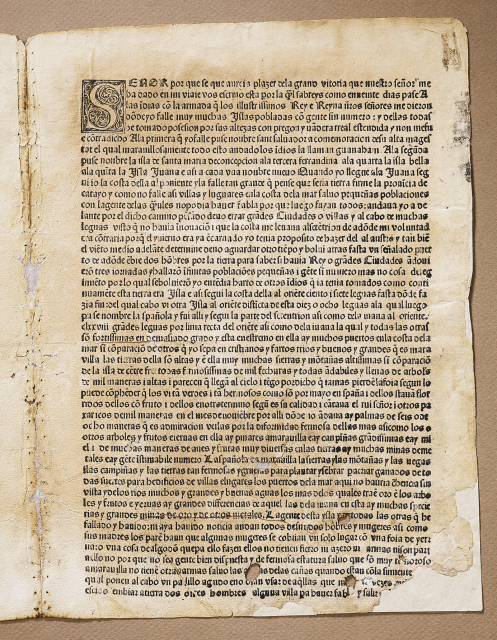
Letter from Christopher Columbus (1451–1506) to Luis de Santángel (d. 1498)
February 15, 1493
Rare Book Division
Letter from Christopher Columbus (1451–1506) to Luis de Santángel (d. 1498)
Transcript below
Anna Deavere Smith: In 1493, during his first voyage back from the New World, Columbus—thinking he'd reached Asia—wrote a long letter in Spanish describing his expedition. His handwritten original no longer survives. But just within weeks of his return, Columbus’s letter was printed—providing Europe with its earliest published account of the peoples and lands of the Americas. This is the only known surviving copy of that first printing.
Paloma Celis Carbajal is the Library’s Curator for Latin American, Iberian, and Latino Collections.
Paloma Celis Carbajal: So, the Columbus letter is addressed simply to a “Senor,” but it is written to Luis de Santángel, one of Columbus’s biggest supporters—and of course, to the queen and king of Spain—with the intention not only to share this extraordinary encounter but also to gain their support for future trips.
Anna Deavere Smith: In his letter, Columbus describes in detail the abundant natural resources of the New World.
Paloma Celis Carbajal: And of course the people there, and their reaction to him. In the first sentence Columbus reports that he has already taken possession of these islands and its people without opposition—“non me fue contradicho,” he says—as if the natives understood what he was doing when he planted that royal flag. So, this will establish the pattern throughout the colonization and conquest of the Americas—in which Europeans claim lands that belonged to others for their own countries.
Anna Deavere Smith: This extraordinary document is a tangible relic of a pivotal, historic moment.
Paloma Celis Carbajal: It also marks the beginning of tragic changes for many ancient civilizations in this continent. Starting with the Tainos—the people Columbus first encounters—and then later on the Aztec, Inca, Navajo, Lenape, and so many more, whose identities, cultures, and scientific knowledge have been systematically suppressed by western civilization. For them, it’s been over 500 years of painful resistance. But against great odds, many of these cultures have survived. Their descendants are still here.
End of Transcript
Paloma Celis Carbajal is Curator for Latin American, Iberian, and U.S. Latino Collections at The New York Public Library’s Stephen A. Schwarzman Building. We gratefully acknowledge the editorial guidance of Kathie Coblentz of The New York Public Library and Dr. Elizabeth Moore Willingham of Baylor University.
No copyright: United States